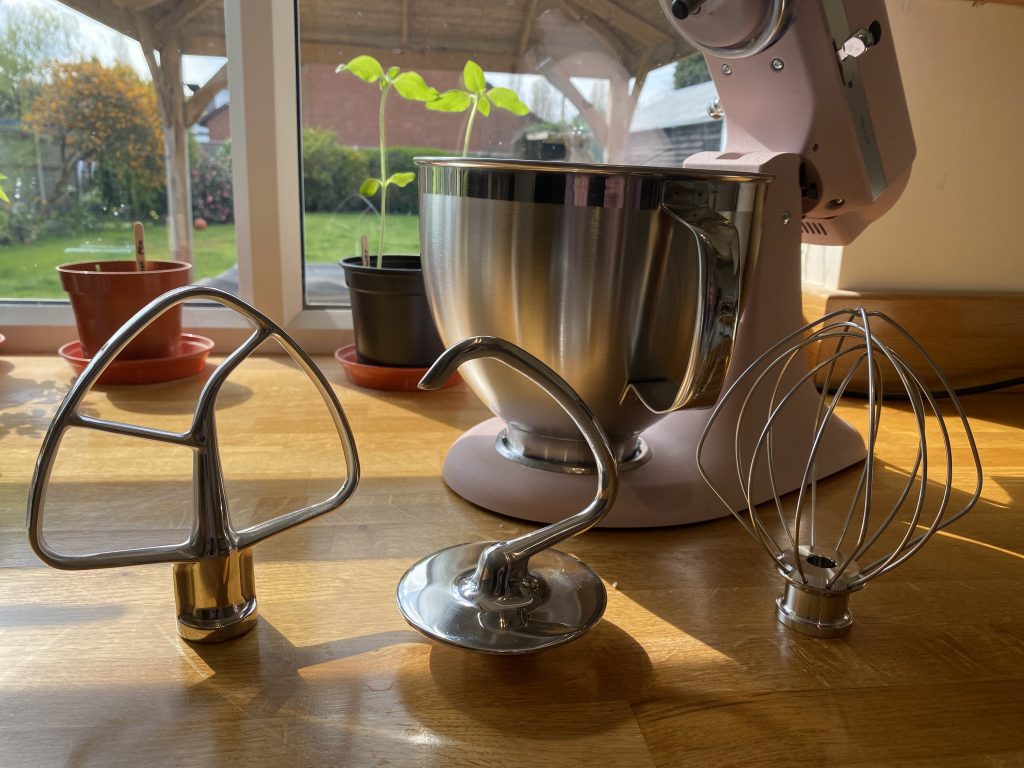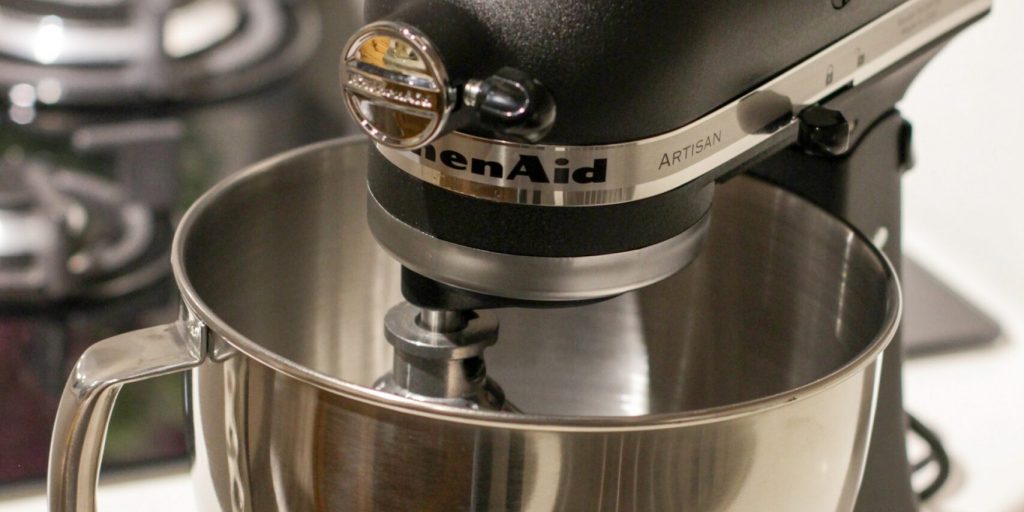Any home chef with a Kitchenaid stand mixer can tell you that’s an invaluable tool when it comes to baking. A stand mixer can take care of repetitive or menial kitchen tasks such as stirring, creaming, and whipping, leaving you free to focus on more important things.
Kitchenaid stand mixers come with a wide variety of accessories that you attach and detach as needed to help you cook like a pro. With so many accessories to choose from, it isn’t always easy to pick the right one for the task. Here, we’re going to go over the best kitchen aid attachments that will work best for your next culinary creation.
Why Use a Kitchenaid Stand Mixer?
Kitchenaid produced its first stand mixer in 1919 as the company’s flagship product. Today, the brand remains a leading name in kitchen appliances. Their stand mixers come in a variety of attractive colors and size options to suit any kitchen.
A powerful motor drives the mixer to give you a variety of speeds, from low and slow for batters to breakneck speeds for whipping. It acts as a second set of hands in the kitchen, making mixing tasks a breeze. If you suffer from mobility issues such as carpal tunnel or arthritis in your hands and wrists, a stand mixer can take some of the pressure off your joints as you cook.
With proper care, a Kitchenaid stand mixer will last for years, if not decades. You can choose between more than fourteen detachable accessories, making the mixer a versatile tool for cooking and baking. The mixer and the attachments are easy to clean with soap and warm water.
A Quick Guide to Kitchenaid Speeds
Kitchenaid mixers have speed settings that range from 2 to 10, with 10 being the fastest. No matter what you’re cooking, it’s best to start slow and amp up to the speed you want. This is especially true when adding powdery ingredients such as flour or sugar. The mixer may end up whipping these up into a cloud at high speeds, which can be potentially dangerous if inhaled.
For baking, you’ll most often keep the mixer at lower speeds for thick dough and batter. You may end up spilling batter or wearing down the motor at higher speeds. For medium-thick mixtures that need pounding or kneading, raise the speed to around 3 to 4.
Creaming ingredients such as sugar and butter takes a slightly higher speed, such as 5 or 6. For beating ingredients such as eggs, it’s best to mix at speeds of around 7 or 8. It’s likely you won’t need to go up to 9 or 10 very often, but these speeds can be useful for whipping ingredients such as cream or milk.
The Best Kitchenaid Attachment for Frosting
There’s no better way to take your baking to the next level than by making your own frosting. While it’s easy to pick up a batch of tasty premade frosting at your local grocery store, making it yourself ensures that you get just the right color, texture, and flavor for your finished piece.
Making frosting is relatively easy, but the process requires some heavy beating. You need to whip the buttercream base enough to make it easily spreadable. A Kitchenaid stand mixer allows you to do this with no problem, but you need to use the right attachment for light, fluffy results.
The best attachment for creaming materials such as butter, cream, and sugar together is the flat beater, also known as the paddle beater. This attachment is ideal for thick, creamy batters that need a little bit of power when mixing, beating its way through to blend ingredients thoroughly.
The flex edge beater is similar to the flat beater. It’s a heavy-duty attachment designed for high-power mixing, especially with sticky or wet batters. A flexible silicon attachment along the side scrapes the bowl’s edge with each pass, ensuring that everything is mixed in completely.
The Best Kitchenaid Attachment for Icing
Icing is thinner than frosting, offering a glossy finish to cakes, muffins, cookies, and more. It usually contains more powdered sugar and less cream than frosting, making it slightly easier to work with. Like frosting, icing requires quick, consistent beating for a smooth consistency.
The best way to make professional-grade icing is by using a stand mixer. With a Kitchenaid, you can set and forget your icing as it mixes and focus on baking instead. Simply crank it up to a high speed and allow it to blend as long as your recipe requires.
The best attachment for mixing icing is the whisk attachment. Stiff wires are rounded into a large balloon shape, with an indent at the end to allow it to fit neatly into the Kitchenaid bowl. Using the whisk ensures that materials mix well while incorporating plenty of air for a light, fluffy texture.
If you’re working with thicker icing, you may want to opt for the flat beater. It’s better able to handle thick batter than the somewhat delicate whisk. You can also switch to the flex edge beater to ensure you’re mixing in any powdered sugar clinging to the side of the bowl.

The Best Kitchenaid Attachment for Cookies
When making cookies, the butter in the batter can get thick enough to make it difficult to mix by hand. With a stand mixer, you can combine all of the ingredients you need without wearing out your arm or shoulder. You just need to make sure that the attachment you use is powerful enough to blend your batter together.
The flat beater is the best cookie attachment for kitchenaid. This heavy-duty attachment allows it to effectively cream and pound ingredients together. If you need even more power to mix your cookies, the dough hook attachment is specially made for kneading and mixing thick batter.
If you’re having trouble with dough sticking to your bowl, try swapping out the hook or paddle for the flex beater attachment. However, be aware that the spatula component doesn’t work well with thick or lumpy material, and so it may not be the best choice for cookies with nuts, oats, or chocolate chips.
The Best Kitchenaid Attachment for Cake
When baking a cake, the batter tends to be relatively thin and watery. You want to make sure that the ingredients are blended well, but you also don’t want to overmix. While many are tempted to use the whisk attachment, it can end up aerating your batter too much.
Most top chefs recommend using the flat paddle or flex paddle when dealing with cake batter. It allows you to mix everything without introducing too much outside air. It’s best to keep things at a low speed the entire time to avoid accidentally overmixing.
Keeping speeds low also helps to prevent splashback. With thin cake batter, however, even low speeds can cause some spattering. The Kitchenaid Pour Shield is an attachment designed to protect you and your kitchen when dealing with potentially messy batters. It fits snugly along the top of your bowl, covering the edges while still allowing you to add fresh ingredients as needed.
The Best Kitchenaid Attachment for Mashed Potatoes
While it’s technically not baking, making mashed potatoes can be very similar to whipping up a batch of frosting. Plenty of home chefs use their Kitchenaid to make delicious, homemade mashed potatoes just a little bit easier to accomplish.
After boiling, baking, or steaming your potatoes, you can place the flesh into the metal mixer bowl while still hot. They should be soft enough to mash with a fork but solid enough to leave some chunks of potato behind.
The best attachment to use when mashing the potato flesh is the flat beater. Instead of slicing through potatoes like the whisk, the beater pounds and mashes the meat with each pass. It creates smooth, creamy potatoes with zero effort leaving you to focus on the main dish.
In Conclusion
A stand mixer in your kitchen can make all the difference when baking. Whether you plan on making a cake or a side dish of mashed potatoes, a Kitchenaid makes the entire process effortless. As long as you know which Kitchenaid attachment to use, you’re bound to get fresh, delicious results every time.
